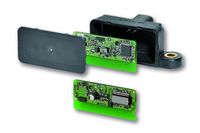World's First Sensor Cluster with Yaw Rate and Acceleration Sensors in one SMD-Component
FRANKFURT AM MAIN, GERMANY – July 23, 2009: Continental, the global automotive supplier, is the first manufacturer in the world to integrate the yaw rate and acceleration sensors required in particular for Electronic Stability Control (ESC) into a single central component. “With this development, Continental is remaining true to its philosophy of making safety systems such as ESC available to all motorists,” said Dr. Ralf Schnupp, Head of Inertial Sensors at the Chassis & Safety Division. “Compact design, a higher level of resistance to vibration and temperature, and lower costs are helping us to achieve this goal. At the same time, the complete integration in silicon technology is offering us the option of making highly-developed assistance systems such as Adaptive Cruise Control or Active Front Steering even more effective through the use of high-precision sensors, and further developing our ContiGuard safety system.” The new cluster will go into series production with several vehicle manufacturers at the beginning of 2010.
Yaw rate sensors in silicon technology
Acceleration and yaw
rate sensors are key to providing ESC with the necessary information about
the vehicle's condition. The system measures the turning speed of the
wheels, the car's lateral and longitudinal acceleration, steering
movements, yaw ratio and rotational speed. It uses all of this data to
accurately calculate in which direction the vehicle is traveling and the
driver is steering. To date, micromechanical sensors have been used
specifically for the acceleration sensor. Now, for the first time ever,
purely capacitive sensors made exclusively from silicon will be used for
yaw rate and acceleration sensing. These are more cost-effective and offer
higher resolution, i.e. increased sensitivity to measurement. They also
ensure only very slight deviations in measurement accuracy in series
production – and, above all, only slight deviations in measurement
readings over a long service life.
One of the biggest challenges facing development engineers when attempting to integrate the sensors into one component was preventing unwanted frequencies and signal cross-talk between sensors. Through the use of silicon sensors, Continental has successfully achieved a higher level of resistance to this type of resonance and vibration, as well as to ambient temperatures of up to 125°C.
The compact design of the sensor cluster means it takes up less space in the vehicle, making it easier to fit and more cost-effective, and also enabling the use of ESC in models of all vehicle categories. Through the integration of the combined yaw rate and acceleration sensor in ESC or airbag control units, reliability in safety-critical applications is increased still further as fewer external components have to be used and linked together.
High precision for additional applications and self-diagnosis
In addition to the standard application for ESC, use of the new sensor
cluster also meets with so-called high-precision specifications. This
further improves the performance of highly-developed systems such as
Adaptive Cruise Control (ACC), Active Front Steering and Intelligent
Headlamp Control. It also increases the accuracy of fault monitoring on
redundant systems. On intelligent cruise control, for example, these more
powerful sensors offer improved radar accuracy.
The highly integrated signal processing monitors and analyzes all internal signals. This covers all levels of the signal chain. If the system detects a fault, it is saved in a separate, non-volatile memory and can be read using diagnostic equipment. This expands the range of diagnostic options, both for the sensors themselves and for the sensor cluster as a whole.In turn, this further enhances the overall product quality and represents a major step towards achieving the Continental quality objective: zero defects.



